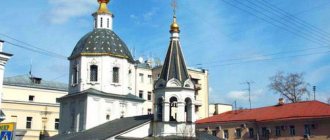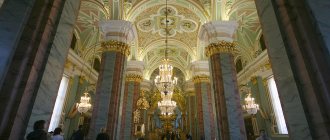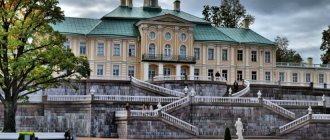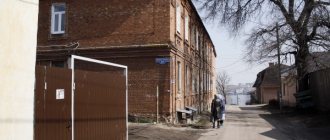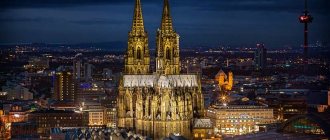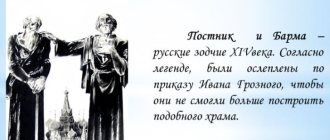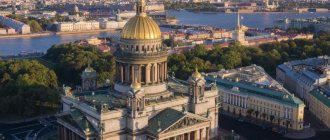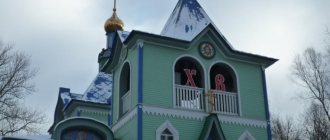| St. Petersburg Church of the Intercession in Bolshaya Kolomna, ca. 1900 |
St. Petersburg Church in honor of the Intercession of the Blessed Virgin Mary in Bolshaya Kolomna
(demolished)
- Altar: Protection of the Most Holy Theotokos (main); St. John the Baptist (right); St. Mary Magdalene (left)
- Address: Russia, St. Petersburg, square on the square. Turgenev
- On the map: Yandex.Map, Google map
The stone church, designed by architect I. E. Starov, was built with donations from parishioners - from 1798 to 1812.
The main altar in honor of the Intercession of the Most Holy Theotokos was consecrated on September 30, 1812; Ioanno-Predtechensky (right) - November 1, 1808; left - in the name of Holy Equal-to-the-Apostles Mary Magdalene - November 20, 1808.
The building was a massive structure with one dome. Its main, western facade was decorated with an impressive Doric portico, above which a two-tier bell tower rose. The church was distinguished by clarity of volume, rigor and noble simplicity of architectural forms. Its interior made a solemn impression, the design of which was based on a combination of heavy pylons and light pilasters. The central nave was closed by a rather interesting iconostasis, which largely preserved the original form, traditional for Empire iconostases of the early 19th century. It was built according to Petrov's design. The images for the iconostasis were made by academicians, the Malkov brothers.
| Market on Pokrovskaya Square, St. Petersburg, between 1909 and 1914. Photo from oldsp.ru |
In 1814 - 1816, according to the design of the architect V.P. Stasov, the church was surrounded by an iron fence with two chapels.
During the reconstruction in 1849, side extensions were made, into which the side altars were moved. The temple was consecrated again in 1852.
After perestroika in 1899 - 1902, according to the project of civil engineer S.P. Kondratyev, all the aisles became the same.
There were three stone houses near the church. The clergy consisted of three priests, a deacon and three psalm-readers. They did not receive a salary and existed only on income from performing parish services and donations from parishioners.
In 1899, the number of parishioners was 3,443 men and 4,531 women.
In 1922, the temple belonged to the Petrograd autocephaly, then, until July 1923, it was a renovationist church.
| Demolition of the Church of the Intercession in Bolshaya Kolomna, St. Petersburg, 1936. Photo from oldsp.ru |
On August 21, 1932, the temple was closed.
Demolished in 1936 [1]. On May 29, 1998, the opening ceremony of a memorial sign took place on the site of the destroyed temple. The sign contains a mosaic icon of the Mother of God and engraved words of prayer to the Blessed Virgin Mary. On the reverse side of the sign you can read the poetic lines of A. S. Pushkin about the Church of the Intercession:
I love to fly, falling asleep in reality,
To Kolomna, to Intercession - and on Sunday
Listen to Russian worship there.
[2]
Story
Vytegra Pogost is located seven kilometers from the city of Vytegra in the Vologda region. Built in 1708, the wooden Church of the Intercession of the Blessed Virgin Mary can be called one of the highest achievements of Russian architecture.
In 1956, the famous architect and restorer Alexander Opolovnikov compiled measurements of the temple with the aim of restoring it to replace the late wooden paneling and restore lost parts. But the project was never implemented, because in 1963 there was a fire that destroyed this architectural monument. According to one version, it was struck by lightning, but there were rumors that the temple was damaged due to someone’s hooligan actions.
History of the first wooden church.
material provided by a student of secondary school 207 Vorobyova S.
In those days, the population of Russia, especially the peasant part, was distinguished by deep piety and religiosity. Therefore, it is not surprising that the first residents of Rybatskaya Sloboda tried to build their temple as quickly as possible in the name of the Intercession of the Most Holy Theotokos. There is even a version that says that the church was brought with them by fishermen who were resettled from the Oka to the Neva by order of Peter I. Allegedly, they brought the temple with them, dismantling it into logs, and then reassembling it again, which, however, is unlikely. One way or another, the exact date of its creation is unknown.
Little is known about the external appearance and interiors of the wooden church, although in the report of the governor of Rybnaya Sloboda dated January 1, 1748, it was possible to find indications of some of the images located there: the holy martyr Emelyan, the holy Prophet Elijah, the holy Prophet Elisha, the image of Blaise the Wonderworker, the image of the Virgin Mary “Joy to all who mourn”, the image of the Savior, the image of St. Nicholas the Wonderworker and the Kazan Icon of the Mother of God. The throne was approximately 1 arshin 9 vershoks in height, 1 arshin 6.5 vershoks in length and 1 arshin 5.5 vershoks in width (1.11x0.99x0.95 m); altar - 1 arshin 7 vershoks in height, 1 arshin 5 vershoks in length and 1 arshin 1.5 vershoks in width (1.02x0.93x0.71 m); in any case, this follows from the size of the clothes on the throne and the altar.
The main income of the church, as follows from the books of income and expenditure, which were kept by the church warden (now located in the fund of the Tsarskoye Selo palace administration in the RGIA), were monthly fees, which gave an average of 80 rubles per month, from the sale of candles, and what was collected from images and into “wallets”; expenses consisted of spending on the purchase of wine, flour, wax for candles; quite often it was necessary to purchase various materials, especially shrouds for rituals and various needs. Although the income was replenished quite unexpectedly: for example, in 1762, after the death of her husband, the peasant woman Pelageya Kuzmina gave her shop to the church. As a result, expenses rarely exceeded income; as a rule, some amount was even left over.
By decree of the confessor of Her Imperial Majesty Theodore Dubyansky dated February 21, 1742, Vasily Alekseev was appointed the first priest of the church. Two years later, on March 8, a sexton also appeared in the church - the son of Father Vasily, Semyon. Until 1746, they served without pay, which they began to receive only after a decree dated April 9, 1746: priest - 25 rubles, his son - 5 rubles. in year. There was no malt bread in the church at that time. It should be noted that in the 18th century, only a few church clergy in Russia received government support. Most of the clergy, both urban and rural, fed themselves exclusively from offerings received from parishioners, or from income from church land. So the local clergy had to rely solely on voluntary offerings from parishioners and income from hay lands allocated by the Tsarskoye Selo patrimonial government, and since these were clearly not enough, the Tsarskoye Selo government was forced to assign him a government salary. There were no special clergy houses at the church to accommodate the clergy: father and son first lived in the house of the church elder Semyon Shchovkin, then at their own expense they built a wooden house, directly opposite the church. The area on which it was located was 60 fathoms (127.8 m) in one direction, 25 (53.25 m) in the other direction, towards the stream. It was 12 fathoms (25.56 m) wide on one side and 7 fathoms (14.91 m) on the other.
By imperial decree of September 10, 1750, Erast Timofeev was appointed the next priest. Erast Timofeev married the daughter of father Vasily and Marfa Afanasyeva, Irina.
After Erast Timofeev, Alexey Yakovlev, a former sexton in the church since September 30, 1753, became a priest. He built his own wooden house, where even after the death of his father Alexei, his wife and son Ivan, who was a sexton in the same church, continued to live. It was under priest Alexei Yakovlev that the construction of a stone church began.
In 1771, on December 20, Ivan Ivanov became a priest. It was he who became the last priest of the wooden church in Rybnaya Sloboda and the first stone one.
Reconstruction of the Church of the Intercession
The temple was restored in the Vsevolozhsk district of the Leningrad region in the Nevsky Forest Park with the blessing of His Serene Patriarch Alexy II of Moscow and All Rus'. On October 16, 2003, a worship cross was installed on the site of the future temple, and on October 26, 2004, a prayer service was served in honor of the start of construction of the temple and the first pile was driven.
All the main work on logging and cutting down walls, making domes and ploughshares was carried out in the suburbs of Petrozavodsk. Upon reaching the 18th crown in April 2005, the temple was transported to the Nevsky Forest Park and work on laying the foundation was completed here. The stones of the burnt Church of the Intercession of the Vytegorodsky churchyard were laid at its foundation. On July 26, 2006, a cross was installed on the central dome, and on October 14 of the same year, the temple was consecrated in full rite by Metropolitan Vladimir of St. Petersburg and Ladoga.
At its core, the temple has the shape of a cross, its height is 19 meters, length is 32 meters and width is 30 meters, the number of chapters is 25.
The Church of the Intercession is the dominant feature of the complex called the Church Pogost in the name of the Intercession of the Blessed Virgin Mary. It also includes a bell tower, the Holy Gate and a fence. The bell tower is a recreated bell tower of the Nizhne-Uftyug churchyard in the Vologda province of the 1670s. The holy gates and fence were created by reconstructing the fences of the Lyadinsky and Spassky churchyards of the Kargopol district of the Olonets province at the end of the 18th century. There is a small chapel nearby. The Pogost will also include a copy of Mankin's house in the village of Kaskesruchey in Karelia from 1889 and a temple museum - the restored Kostin House from 1871 in the village of Verkhovye in Zaonezhye.
In turn, the churchyard of the Church in the name of the Intercession of the Blessed Virgin Mary will become part of a large-scale complex called “The Bogoslovka Estate”, where the Spasskaya Church and the Voivode’s House of the wooden Kargopol fortress of 1664–1665, which burned down in 1731, will be recreated. A pilgrimage center with a refectory and a hotel for 60 people, a Russian ethnographic park and a pier for cruise ships will be built here.
Abbots
- Boris Albensky (April 2, 1802 - March 1840)
- Vasily Polyansky (April 8, 1840 - April 1850)
- Gavriil Mikhailov (Georgievsky) (April 15, 1850 - July 3, 1853)
- Andrei Pavlovsky (July 10, 1853 - October 1855)
- Grigory Dobrotvorsky (October 1855 - January 1860)
- Sila Tapilsky (January 14, 1860 - December 26, 1860)
- Fyodor Iovlev (December 30, 1860 - December 13, 1879)
- Vasily Knyazhinsky (December 29, 1879 - February 17, 1882)
- Ivan Gorsky (February 23, 1882 - August 1885)
- Pyotr Soloviev (August 21, 1885 - September 11, 1898)
- Vasily Akimov (September 15, 1898 - May 1922)
- Dmitry Lyubimov (May 1922 - September 1922)
- Nikolai Chepurin (September 1922 - July 1923) [3]
- Vasily Akimov (July 1923 - August 21, 1932)
At the design stage of the university campus, it was planned to build a house church
Even during the construction phase of the entire campus, it was planned to build a house church. The life of this house church is closely connected with the life of the educational institution.
After the end of each school year, a divine liturgy was held in the temple. The rector of the temple not only conducted services, but also taught the Law of God.
The opening of the temple coincided with the opening of the university.
In the project it was decided that the temple should be located on the second floor of the main building of the institute. It was decided to build the altar on the north side, and one could enter the temple from the reading room.
This is what the reading room looked like at the Polytechnic Institute in St. Petersburg. At the end of the hall, behind the arch, was exactly the same house church
Capacity should be no more than 300 people. This option was approved by the Holy Synod.
Soon finishing work began in the reading room and library. But the house temple was not built. Considerations came to build a separate church. This decision came due to the small space in the library, as well as strangers who could also enter the temple to pray. But the funds were not enough.
1906
this year a refusal to build a house church was adopted
Soon, several events affected the work and construction of the polytechnic institute. On January 9, one of the students was shot. To avoid new victims, students were dismissed for the holidays, and then classes were completely canceled until the next academic year.
In the new academic year, classes lasted only one month due to the All-Russian strike in 1905. Classes in many educational institutions were also suspended.
As a result, classes were interrupted until 1906. In the same year, the authorities’ refusal to build a house church in the reading room was accepted.
In 1908, a new director appeared at the institute, who raised the question of the need to build a church at the institute.
Ivan Vsevolodovich Meshchersky is a Russian and Soviet scientist mechanic. It was he who became the new director of the Polytechnic Institute, who raised the question of the need to build a church at the institute
In March 1909, this issue was actively considered in the State Duma. Soon it was decided to create a church at the Polytechnic Institute. It was also decided to teach such a subject as theology in some departments of the institute.
The priest of the Yaroslavl Theological Seminary, Archpriest Mikhail Vasilyevich Troitsky, was chosen to read this subject.
On September 30, it was decided to name the university after Emperor Peter the Great. In January 1910, Nicholas II signed a decree that the Polytechnic Institute in St. Petersburg began to have a new name in honor of Emperor Peter the Great.
But the temple was never built. The next director also raised the issue of funding for the church institute. In 1910, the authorities again tried to resolve this issue. Even students of the institute wrote in writing with a request for the construction of a temple.
At the end of May the director resigned and they were constantly changing over the next 3 years. But each of them tried to make their contribution.
Construction of a stone church. The first years.
From archival documents it follows that the decree on the construction of a stone church in the settlement was received on June 2, 1765, a few days later (on the 7th) a book was issued to priest Alexei Yakovlev to raise funds. By 1767, all materials and projects approved by Father Theodore Dubyansky and the Empress personally had been prepared. The court councilor and architect Mylnikov and the local architect Neelov took part in the project. On May 13 of the same year, a blessing was requested for the construction of the church from His Eminence Archbishop Gabriel; moreover, he himself came to the foundation ceremony and laid the first stone with his own hands. Construction began on June 8, the estimate was 10,696 rubles 50 kopecks, issued by the Empress through Father Theodore Dubyansky. Due to a constant lack of funds, construction periodically stopped, even despite 3,000 rubles issued for payment of debts and completion in April; but by 1773 the building's vaults had been reduced; finishing work remained. contracts for work were awarded at public auctions, which took place on June 13, 14 and 15, 1773. As a result, the plastering work was entrusted to Vasily Petrov and his son Kasaurov for the amount of 1,187 rubles, and the carpentry and carving work was entrusted to Vasily Petrov, a retired carving apprentice, and master Stepan Fedorov from the St. Petersburg carving workshop for the amount of 450 rubles.
The construction was completely completed in 1773, at the same time the church was consecrated, but the temple did not have bell domes, and again there was not enough money for completion. the area of the church was about 70 fathoms (317.6 sq. m). The collection of money began only in 1774, at the end of January. And the wooden church existed at that time and was located to the right of the temple under construction. On May 1, 1784, Metropolitan Gabriel of Novgorod and St. Petersburg received a petition dated April 29 of the same year, in which the residents of Rybnaya Sloboda asked for permission to demolish the wooden church; the resolution imposed read “allow.” Later, on the site of the altar of the wooden church, a brick monument was erected with the inscription: “In this place was the altar of a wooden church that existed from the time of the first settlement of the Fisherman’s Settlement,” which was replaced in 1862 by another one, made of Serdobol granite, which has not survived to this day. From the iconostasis of the wooden church, 4 images remained: the image of the Savior, the image of Elijah the Prophet, the image of the Mother of God and the image of St. Nicholas the Wonderworker.
On April 29, 1784, the village residents received the metropolitan's blessing to build a church in the name of the Nativity of Christ, for which they planned to add a second floor to the church. Work began on June 16 and ended on July 24, 1784.
Stone church in Rybatskoye before perestroika
Church in the 19th century (until 1884).
Interior view of the first stone Church of the Intercession of the Blessed Virgin Mary in Rybatskoe In 1843, renovation work was carried out in the church; one of the local brick makers and at the same time the church warden, Fyodor Nikiforovich Slepushkin (1763 - 1848), donated 10 thousand rubles. With this money, a two-tier iconostasis was recreated; Most of the images were also painted new by the artist Kuznetsov. The ceiling was mosaic, under the slopes of the dome the evangelists were depicted, in the altar above the throne - God the Father blessing, and above the entrance doors hung a small icon of the Apostle Andrew. On a high place, the same author painted an icon of the Holy Trinity, with John the Baptist and the Mother of God standing, and on the western wall there were two paintings: miraculous fishing on Lake Gennesaret and the healing of the lame man by the Apostle Peter. The height of the temple was about 4.5 meters, with a wooden dome - a little more than 7 meters.
Since 1834, there was a cemetery wooden chapel assigned to the Church of the Intercession. By the end of the 19th century. it has fallen into disrepair. After the events of March 1, 1881, parishioners wished to build a church in the cemetery in the name of the Kazan Icon of the Mother of God.
At the end of Ust-Slavyanka, one and a half miles from the church, there was a stone chapel, covered with iron, with a dome and a cross - in the name of St. Prophet Elijah, built in 1861 by brick manufacturer Stepan Stepanov in memory of the death of livestock in 1815.
(E. A. von der Brüggen, N. M. Evreinov Laurels, monasteries and churches in Holy Rus'. St. Petersburg Diocese. St. Petersburg Printing House of the School of the Deaf and Dumb VUIM 1909, pp. 83-84)
On January 29, 1865, the rector of the church at the Porcelain Factory, Ivan Nikiforovich Pogonyalov, consecrated the side chapels, built with church money and donations; in particular, it is known that local and Ust-Slavic factory workers donated 105,000 bricks for construction. The work, which began in 1862 and ended in 1864, was carried out according to the design of the architect Karpov. The reason for their creation is obvious - the temple was very crowded, which was especially felt during major holidays. As a result, the lower floor had three altars, antimensions, which had been consecrated four years earlier. The main one, respectively the middle one, was dedicated to the Protection of the Most Holy Theotokos. In 1864, it was updated; the icon painter Paskin painted an iconostasis in two tiers, decorated with carvings and gilding, for which this church was later famous. Its length was 10 meters 31 centimeters, and its width was 6 meters 40 centimeters. The right chapel was dedicated to St. Nicholas the Wonderworker, the left - to the Tolga Icon of the Mother of God.
The church was crowned with a wooden dome decorated with a copper, gilded cross. The roof was covered with iron only in 1826. Directly adjacent to the building was a bell tower with ten bells, the largest of which weighed 343 pounds and 33 pounds - that is, more than 5.5 tons. The building was surrounded by a fence with a stone chapel with a gate on which the Intercession and the Apostles Peter and Paul were depicted; This fence was built in 1872-73. There was also a cemetery next to the church.
Estate "Bogoslovka": Church of the Intercession and other monuments of wooden architecture
In the past, the Russian North was decorated with numerous wooden churches. Nowadays, grains of them remain. Huge northern houses and outbuildings are becoming a thing of the past. How to save them? After all, wood is a short-lived material: it burns, rots, and collapses over time.
You can transport these buildings to museums of wooden architecture. At the same time, the connection between the monument and the surrounding landscape in which it was created and existed for centuries is severed. However, sometimes this is the only chance to save it. Perhaps, if at one time the Assumption Church in Kondopoga or the Intercession-Vlasievskaya Church of the Lyadinsky churchyard had been transported to such a museum, they would not have perished in the fire. But what to do if the monument no longer exists, it is irretrievably lost? Then the only possibility remains to recreate it. Let it be a remake, but thanks to the measurements made by experienced restoration architects, it is the most accurate copy possible.
***
One of these places where you can see recreated masterpieces of wooden architecture is the Bogoslovka Estate ethnopark under construction in the Nevsky Forest Park of the Vsevolozhsk district of the Leningrad region, which is often called the St. Petersburg Kizhi.
Pokrovsky churchyard in the Bogoslovka estate
The Bogoslovka estate was not born out of nowhere. In the 17th century, this picturesque area in a bend of the Neva belonged to Sweden and was called Wallitula krog - “Valitovsky tavern”. In 1747, Empress Elizabeth Petrovna gave it to her confessor, Archpriest Fyodor Yakovlevich Dubyansky (1691-1769), a highly educated man who had great influence at court. He was also the confessor of Catherine Alekseevna, the future Empress Catherine II, and helped her in those difficult times when she fell out of favor at court. His son, Mikhail Fedorovich Dubyansky (1733-1776), took an active part in the palace coup of 1762, after which Peter III was removed from power and Catherine ascended the throne.
Fyodor Yakovlevich Dubyansky. Portrait by Alexei Antropov, 1761
Fyodor Yakovlevich built a small manor here and laid out a park. At the end of the 18th century it began to be called Bogoslavskaya, or Bogoslovskaya. On the Semitopographic map of the circle of St. Petersburg and the Karelian Isthmus of 1810 it is designated as “Boguslavskaya manor”, and on the map of the St. Petersburg province of F.F. Schubert in 1834 - “Dubyansky’s dacha”. In 1828-1831, when the estate was owned by Alexander Mikhailovich Dubyansky , not far from the confluence of the Chernaya River with the Neva, according to the design of Academician Vikenty Ivanovich Beretti (1781-1842), a manor house was built in the “wooden Empire” style. Its distinctive feature was the carved finishing details.
The Zinoviev estate house with the main staircase and grotto, photograph from 1910
In 1843, the great-grandson of F.Ya. Dubyansky, Adjutant General Nikolai Vasilyevich Zinoviev (1801-1882) - the son of Varvara Mikhailovna Dubyanskaya (1763-1803) and Senator Vasily Nikolaevich Zinoviev (1755-1827) - became the heir to the estate. In front of the manor house, on the slope facing the Neva, a staircase with marble busts was built.
Nikolai Vasilievich Zinoviev. Unknown artist, 1829
The last owner of the estate was N.V. Zinoviev’s nephew, State Councilor Stepan Stepanovich Zinoviev (1838-1918). Under him, part of the estate was rented out to summer residents, and the other, thanks to the well-established economy, brought in considerable income.
After the October Revolution, the Zinoviev estate, which by that time occupied about 1,000 acres, was nationalized. The state farm dormitory was located in the Zinovievs' house. In 1932, the estate park was renamed Nevsky Forest Park . During the Great Patriotic War, it found itself in the zone of continuous shelling and was badly damaged, about 90% of the trees died. After the war, the park was restored, but fell into disrepair in the 1990s. From the luxurious manor house, the remains of the foundation have survived to this day, and from the park only ancient alleys and ponds on the Black River have survived.
In 1995, the “Ensemble of the Zinoviev Estate” was included in the List of Historical and Cultural Objects of Federal Significance. It was decided to create an ethnopark of lost monuments of wooden architecture of the 17th-19th centuries here.
***
Let's take a closer look at some of the attractions of the Bogoslovka estate - Pokrovsky Pogost . It owes its fame to the “Petersburg Kizhi” to the multi-domed Church of the Intercession from the Vytegorsky Pogost .
- On topic: What is a graveyard?
Holy Gates from the Spassky Pogost
Not far from Vytegra, a city in the north of the Vologda region, there is the Vytegra Pogost (the village of Ankhimovo). In 1708, a wooden 25-domed Church of the Intercession of the Blessed Virgin Mary . It became the predecessor of the 22-domed Church of the Transfiguration in Kizhi, built six years later, in 1714.
- On the subject: History, attractions and museums of Vytegra and its surroundings
Church of All Saints and the Intercession of the Blessed Virgin Mary; photograph of Sergei Prokudin-Gorsky, 1909
The historical and artistic value of the Church of the Intercession is difficult to overestimate: it, like the other, Kizhi, temple, being, in essence, one of the achievements of Russian wooden architecture, at the same time represents a typical monumental structure of Obonezhie of the Peter the Great era.
A.V. Opolovnikov. Treasures of the Russian North. M., 1989. P.85
A local legend tells about the history of the emergence of the Intercession Church:
During the reign of Peter I, in the Vytegorsky churchyard, in the village of Kryukova, there lived one very rich peasant, nicknamed Plotnikov, who had only one literate son. During Peter's passage, when he was examining the local area in view of the connection of the Volga with the Baltic Sea, the son of the rich man Plotnikov fell into disgrace with the Sovereign and was, by His command, executed, for the fact that when Peter's sergeant came here to procure horses, he ( son) read some decree of the Sovereign in a hat and mittens, which showed disrespect for the Sovereign’s Person and, moreover, was a lot rude to the sergeant. The sergeant conveyed all this to the Emperor, and in an exaggerated form. Peter, being out of sorts, immediately gave the order to execute the culprit.
Old man Plotnikov, having heard such a strict sentence, fell at the feet of the Emperor and begged to spare his son, offering him all his enormous wealth: but Peter remained adamant, and the son was immediately executed.
Heartbroken and not knowing who to leave his wealth to, Plotnikov, even before the Tsar’s departure, decided to build a rich church in memory of his executed son over his grave, and immediately made a request for permission to carry out his idea. This time Peter heeded the request and immediately drew a drawing, according to which this church was subsequently erected
Another legend says that a Dutch architect invited by Peter took part in the creation of the Church of the Intercession. However, this seems unlikely: multi-domed temples in Rus' have been built since ancient times.
The volume-spatial structure of the Church of the Intercession in the Vytegorsky Pogost, as well as the Church of the Transfiguration in Kizhi, was based on a twenty-walled structure - an octagon with four cuts. In the temple there was an ancient four-row tyablo iconostasis, the ceiling was made by “Heaven”.
Church of the Intercession near Vytegra. Plan. Measurement. From the book: A.V. Opolovnikov. Treasures of the Russian North. P.73
Church of the Intercession near Vytegra. Lengthwise cut. Measurement. From the book: A.V. Opolovnikov. Treasures of the Russian North. P.75
Both outstanding monuments of Russian wooden architecture - the churches in Vytegra and in Kizhi - are so firmly connected by ties of genetic kinship that they can be considered blood sisters.
A.V. Opolovnikov. Treasures of the Russian North. P.77
However, the Transfiguration and Intercession churches have significant differences. Thus, in the Church of the Intercession there are not three, but only two successively decreasing octagons; the refectory is not rectangular, but with beveled corners; three, and not one altar block, as in the Transfiguration Church in Kizhi.
- On the subject: About one long-ago journey: sailing along Onego to Kizhi
Spaso-Kizhi Pogost, slide 1988
In 1708, the temple was erected without a foundation, which is why its subsidence began. Therefore, in 1793 it was dismantled and reassembled on a stone foundation. The wooden frame was covered with planks and whitewashed with chalk, which, on the one hand, imitated stonework, and on the other, protected the logs from moisture. In addition, four chapters were filmed on the christened barrel. Another restoration was carried out in 1880, after which the temple lost the small dome above the porch.
View of the church and bell tower of the Vytegorsky churchyard. From the album “Views (in different parts) of the waterways of the 2nd district of communications. 1865"
In 1898, at the expense of a local philanthropist, merchant of the first guild and honorary hereditary citizen Alexander Fedorovich Loparev, the interior decoration of the temple was “renovated”. As a result, in the words of the restoration architect A.V. Opolovnikov, the “strict and majestic in its simplicity”, the original architecture of the Intercession Church was distorted beyond recognition.
After the October Revolution, services in the Intercession Church were stopped. Until 1948, the temple was considered an architectural monument and was under the jurisdiction of the regional local history museum and the architecture department of the Vologda Regional Executive Committee. Believers repeatedly asked to hand over the Church of the Intercession to them, and divine services almost resumed, but bureaucratic delays arose that prevented this. The former temple is empty.
In October 1963, the Church of the Intercession burned down.
The head of the Vytegorsk police, Volkov, says that the fire was the result of an accident. Two drinkers entered the church through a window and, drunk, accidentally set it on fire. Residents of Ankhimovo directly say that the church was not actually guarded. The door, however, was locked, but the windows were not sealed, and through them anyone who wanted to entered the church could enter. It became cluttered and became a passageway for drinkers. So, in 1961 there was already a warning incident when hooligans entered the church - they broke utensils and damaged icons. However, the Ankhimovsky village council did not take effective measures.
Newspaper “Vologda Komsomolets” dated November 15, 1963
Only the ruins of stone churches of the Vytegorsky churchyard have survived to this day: the winter Church of the Savior of the Image Not Made by Hands, built in 1780, and the Church of All Saints, built in 1905.
Fortunately, detailed photographs, measurements and plans for the restoration of the Intercession Church, made by the Soviet architect and restorer Alexander Viktorovich Opolovnikov, have been preserved. In 2003-2008, the Church of the Intercession in Bogoslovka was built according to them, the progress of work was supervised by the daughter of the architect E.A. Opolovnikov.
Church of the Intercession in Bogoslovka
Work on the reconstruction of the Church of the Intercession began in December 2004. In the suburbs of Petrozavodsk, 18 crowns of the log house were stacked and then transported to the Nevsky Forest Park. Domes and ploughshares were also made in Petrozavodsk. The foundation stones of the Intercession Church in Bogoslovka were laid from the foundation of the burnt Intercession Church in the Vytegorsky churchyard.
Church of the Intercession in Bogoslovka
The new temple was recreated in its original forms: 25-domed, without planking. The dimensions of the church are impressive: length is 32 meters, width - 30 meters, height - 19 meters.
Church of the Intercession in Bogoslovka
The main altar, attached to the eastern apron, as well as the side altars, attached to the northern and southern aprons, are pentagonal. The outer walls of the altars are hewn “to nothing.”
Church of the Intercession in Bogoslovka
Log frame of the Church of the Intercession “without a trace”
On October 14, 2008, the Great Consecration of the temple took place according to the episcopal rite, which was led by Metropolitan of St. Petersburg and Ladoga Vladimir (Kotlyarov).
Domes
Porch detail
Based on available measurements, photographs and drawings, restorers restored the interior decoration of the Church of the Intercession. Of course, in a newly built church there is no “prayer” and the spirit of past eras that is inherent in old churches. But several decades will pass, and the Church of the Intercession in Bogoslovka will have its own history.
Interior decoration of the Church of the Intercession
An ancient shrine is kept here - the altar Gospel, printed by order of Peter I for the Intercession Church of the Vytegorsky Pogost in a Moscow printing house at the beginning of the 18th century.
Iconostasis
Painted "Sky"
Interior decoration of the Church of the Intercession
To avoid fire, candles are placed in sand.
Candles in front of the icon of the Virgin Mary
Interior decoration of the Church of the Intercession
Next to the Church of the Intercession there is a bell tower. Its prototype was the lost bell tower of the 1670s from the Nizhne-Uftyugsky churchyard of the Vologda province (now the Nyuksensky rural settlement, Nyuksensky district of the Vologda region).
Intercession Church and bell tower
The bell tower was recreated according to the measurements of the architect V.V. Suslov, completed in 1884. Every quarter of an hour the bells on it chime the melody “God Save the Tsar.”
Measurements of the bell tower from the Nizhne-Uftyug churchyard, made by V.V. Suslov. Published on page 18 of the first issue of “Monuments of Ancient Russian Architecture”
Recreated bell tower from the Nizhne-Uftyug churchyard
Recreated bell tower from the Nizhne-Uftyug churchyard
Recreated bell tower from the Nizhne-Uftyug churchyard
Recreated bell tower from the Nizhne-Uftyug churchyard
Bells
Next to the Holy Gates, almost at the entrance to the estate, there is a small chapel of the Savior Not Made by Hands . This is a copy of a chapel of the late 18th - early 19th centuries from the village of Kirillovo, Kargopol district. Recreated according to the measurements and reconstruction plan of Andrei Borisovich Bode.
Chapel of the Savior Not Made by Hands
Chapel of the Savior Not Made by Hands
Chapel of the Savior Not Made by Hands
Chapel of the Savior Not Made by Hands
On the territory of the Bogoslovka estate there is also a copy of the residential house of the peasant E.A. Kostin from 1817 from the village of Verkhovye, Velikogubskaya volost (now the Medvezhyegorsky district of the Republic of Karelia). The house was recreated based on measurements from 1940 and 1995, as well as photographs from 1926, 1940, and 1990s. The Museum of the Intercession Church is located here.
House of E.A. Kostin
Plans of the 1st and 2nd floors of the house of E.A. Kostin from Velikaya Guba
Farm yard and forge
Utility yard
Gate to the utility yard
House of E.A. Kostin
House of E.A. Kostin
House of E.A. Kostin
Spasskaya Chapel and Kostin's House
Not far from Kostin's house there is a workshop . True, it seemed a little neglected to me.
Workshop
This is how church domes are created
Another attraction of the ethnopark is the fence of the Pokrovsky churchyard , which is a copy of the fence of the churchyard of the village of Lyadiny, Kargopol district, Olonets province (now Kargopol district, Arkhangelsk region). The Holy Gates are a copy from the Spassky churchyard of the 18th century from the village of Verkhneye Gurye, Kargopol district, Olonets province (now Prionezhsky district of the Republic of Karelia). Recreated according to the design of Boris Dmitrievich Lurie.
Holy Gates of Spassky Pogost
Pokrovsky churchyard in the Bogoslovka estate
Pokrovsky Pogost fence
Pokrovsky Pogost
Pokrovsky Pogost
Work at the Bogoslovka estate continues. It is planned that after all work is completed it will include the following buildings:
- Zinoviev estate and park complex : restoration of the buildings of the Zinoviev estate.
- Church graveyard in the name of the Intercession of the Blessed Virgin Mary : Church of the Intercession of 1708 from the Vytegorsky churchyard.
- Bell tower from the Nizhne-Uftyug churchyard.
- Holy Gates and Fence : a combined reconstruction of two fences of the late 18th century: Lyadinsky and Spassky churchyards.
- Kostin's house (1871) from the village of Verkhovye in Zaonezhye.
- Church (parish) house : a copy of Mankin's house (1889), located in the village of Kaskesruchey, Petrozavodsk district, Olonets province (now Prionezhsky district of the Republic of Karelia).
- Worship cross.
- Russian village , which will include buildings of types of peasant estates in the western and eastern parts of the Leningrad region. The total number of yards is 8-10.
Pokrovsky Pogost
***
In conclusion, I would like to add a few of my thoughts about the need for such ethnoparks. At the beginning of the article, I already wrote that wood is a short-lived material. Almost every month in our country, monuments of wooden architecture are destroyed as a result of fires and collapses. Some are due to the fault or malicious intent of a person, such as the already mentioned Assumption Church in Kondopoga. Others disappear simply because villages are emptying and people are leaving. Temples and ancient houses in them are doomed to die. Some die from natural disasters.
Yes, the Pokrovsky churchyard in the Bogoslovka estate is a remake. But what percentage of old logs have been preserved in the restored Church of the Transfiguration in Kizhi or other exhibits of ethnographic museums? Not so much. Therefore, such museums with recreated buildings have a right to exist. There are very successful examples: the tourist village of Verkhnie Mandrogi in the Podporozhsky district of the Leningrad region, the spiritual and educational village in the Sortavala region of the Republic of Karelia and others. Their existence does not negate the fact that antiquity must be preserved and the great heritage of the Russian North must be preserved. Otherwise, future generations will be able to see ancient houses and temples only in such ethnoparks.
Information for travelers
- Address: Russia, Leningrad region, 193149, post office box 20, Vsevolozhsky district, Bogoslovka Estate, Pokrovsky Pogost.
- Travel by public transport: Lomonosovskaya metro station, then bus No. 476 or minibus No. 476-M (towards the village named after Sverdlova) to Bogoslovka park. Bus stop opposite the Pokrovsky Pogost complex.
- Opening hours of the Pokrovsky Pogost: daily from 10 a.m. to 5 p.m., on days of worship: from 9 a.m. to 5 p.m., evening services until their end. Weekends and holidays: from 10 to 19 hours. From June 1 to September 30, the Pokrovsky Pogost complex is open: daily from 10 a.m. to 6 p.m., evening services until their end. Weekends and holidays: from 10 to 19 hours.
- Phones: 8 (911) 906-3030 – Church of the Intercession, 8 (911) 229-3030 – excursion desk, 8 (812) 386-3301 – Intercession Fund
- Website: bogoslovka.ru
- Email address: – Pokrovsky Fund
The Pokrovsky churchyard in the Bogoslovka estate is a church territory, so clothing must be appropriate. At the entrance to the Church of the Intercession, women can take a scarf and skirt. Photography is permitted for a donation.
© Website “On the Roads of the Middle Way”, 2009-2021. Copying and reprinting of any materials and photographs from the site anashina.com in electronic publications and printed publications is prohibited.

